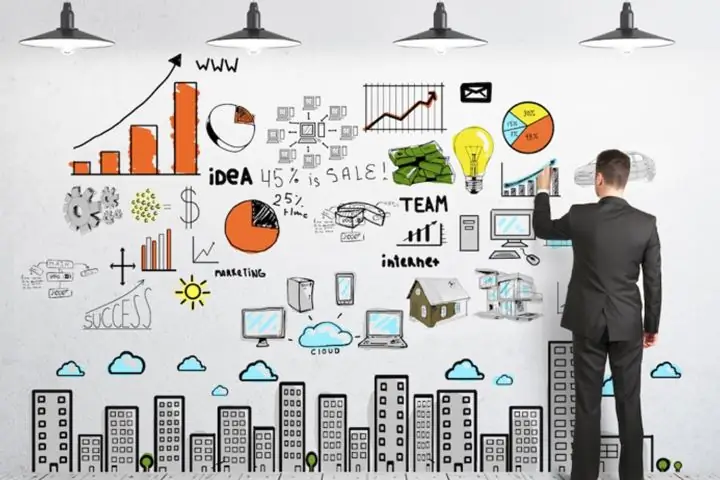2026 Author: Howard Calhoun | [email protected]. Last modified: 2025-01-24 13:10:26
Business is influenced by many factors: competition in ongoing activities, the economic situation of the population, the quality of the goods and services offered, the location of the company and its remoteness from sales points, and so on. But perhaps the most important thing on which the success of the company depends is the organization of enterprise management. A lot depends on this factor. If not all. With the wrong management, even the best product will either not be made in the required volume, or they will miss the deadlines for execution. In this article, we will look at the main organization of enterprise management and analyze the mistakes that should not be made.
The essence of the organization management process
Organization of enterprise management is a purposeful and controlled activity, which is a combination of various methods of motivating and controlling the work of the team to achieve the task (this includes both the global goal of the organization, and short-term ones, such as increasing the sales market,improving product quality, improving sales efficiency, and so on).
The organization of the enterprise management structure is divided into management and managed parts, where the manager is the directorate, the manager and the information department (also called the administrative and managerial apparatus), and the managed is the organizational departments involved in the production process. The success of the organization will lie in the proper coordination of both components.

Goals of the enterprise management system
In order to understand the issue of organizing an enterprise management system, it is necessary to determine its goals. They may be different, but are combined into four main blocks:
- Economic - aimed at increasing sales and increasing the profits of the enterprise.
- Production-commercial - the fulfillment of a given volume of production and sale of the product, aimed at ensuring the economic goal, contractual obligations, and so on.
- Scientific and technical - aimed at obtaining the necessary technical characteristics of the product, aimed at improving quality, as well as increasing productivity as a result of technological improvement.
- Social - aimed at meeting the needs of executive staff.
The economic goal is predominant, while the other three work for it, complement each other. Usually the enterprise works simultaneously on each of them, naturally, dividing responsibilities betweenheads of different departments. An indicator of successful work on the implementation of the goals of the organization will be an increase in sales and an increase in the overall profit of the company, that is, the fulfillment of its economic goal.

Functions of the enterprise management system
The separation and specialization of management and its activities are called the functions of enterprise management by the organization. According to the principle of long-term, there are basic and specific management functions. The main (they are also permanent) functions are planning, organization, motivation and control.
- Planning is aimed at determining the prospects for the development of the economy, predicting its future state and determining the role of the enterprise in the resulting picture. Based on the results obtained, a further action plan is drawn up. Planning includes several successive stages: a concept (a theoretical basis, an idea), a forecast (foreseeing business opportunities using scientific justification), a program (final formation of further activities with a calculation of the resources necessary for implementation).
- The organization is aimed at the formation of leadership, regulation of relations between the managing and managed systems, it also improves the efficiency of all other functions due to the fact that it creates a clear system of managers and ensures their successful interaction.
- Motivation helps to find the reasons that help the team achieve the tasks assigned to it, provides them with them, thereby stimulating effective activity.
- Control - the final stage, which conducts observation for the purpose of verification. The main task of this function is to correct the generated strategy. Control establishes regulatory indicators, then measures and analyzes them, after which it determines actions that contribute to the improvement of these indicators. Recommendations can be different: revising goals, redistributing tasks, attracting personnel, improving the organization of enterprise management.
Specific functions affect a specific area of activity and are due to the separation of the management structure. The object of the function is taken as a separate link, for example, marketing, sales department, administration system. Usually they are short-term and focus on the area that shows unsatisfactory results at the control stage.

Enterprise management structures
Based on the defined functions, the successful execution of which requires different competencies, the composition of the management is formed, which can be one person, a department or a division of managers. The organization of an enterprise management system implies the choice of the most appropriate option. Based on the amount of necessary authority, six management structures are distinguished:
- Linear. In such a structure, management is carried out from the boss to the subordinate along the hierarchy. An important nuance is that orders come from only one person. It is very important to choose the optimal number of employees for one manager, it will depend onefficiency. Such a system has its drawbacks, for example, a complex decision-making process - in order to get approval for any action, a subordinate needs to turn to all those higher in the hierarchy, as a result of which there is a slow reaction in relation to even the most important issues, plus corruption and intrigue are also rampant.
- Functional. In such an organization of enterprise management, functions common to several departments are transferred to one department or a person who executes orders from several bosses. The advantage of the structure is the complete elimination of duplication of the work of the performer, the minus is the lack of unity of orders, which, as complexity increases, can slow down the workflow.
- Linear-functional. This structure combines the previous two: decisions are developed by qualified specialists, after which orders are given down the hierarchy.
- Program-targeted. With such management of the organization of labor at the enterprise, the leaders of each individual project are allocated, after which they give orders aimed at achieving individual goals of the company. The manager receives a task from the director or his deputy, while having a staff of employees subordinate to him. Over time, these departments often evolve into independent in-house firms.
- Matrix. Such a structure combines at once a linear, program-targeted and functional organization.
- The divisional structure combines product and regional principles. The fundamental parts here will be departments endowed witha certain independence, entering into contractual relations with each other and independently financed through profit. At the same time, management makes decisions for the long term.

Social patterns influencing the choice of enterprise management structure
The organization of the enterprise management structure should be chosen from certain social patterns that have an impact on the course of the company's activities as a whole. These laws include:
- The technical and economic law, which reveals the essence of the technical side of production, reflects the relationship of man to technology and nature.
- Social and socio-economic laws that show the essence of the relationship between individual classes.
- Legal.
- Socio-psychological laws that show the essence of the relationship between employees and entire departments in the company, their interaction with each other.

The principle of effective construction of the enterprise management structure
Successful organization of enterprise management begins with certain rules of construction, principles that must be relied upon when choosing the structure and methods of management. Firstly, we must not forget that the main source of productivity increase is always a person, therefore, based on his psychological and social qualities, an effective program of the company's work should be drawn up. Moreover, if you provide employees or departments with someautonomy, their effectiveness will increase significantly. However, the freedom of employees must be combined with centralism and leave the main goals to employees - quality standards, company policy.
The next principle is that planning should always have a long-term perspective and be based on a constantly changing market. The company must also be ready to expand staff if necessary. When choosing a management system, it is necessary to focus on the most simple and understandable forms, not to complicate the management process. And of course, do not forget about the interests of consumers.

Methods of enterprise management system
The method of management is a way of influencing employees and the team as a whole, the purpose of which is to ensure the coordination of their work to obtain the necessary results. According to the content, methods of organizing enterprise management are divided into three broad groups:
- Administrative methods are based on the subordination of employees down the hierarchy and are divided, in turn, into organizational and managerial. The former cover entire management structures and give a clear division of responsibilities, they appear in the general instructions and norms of the enterprise. The latter constitute a prompt response and appear in the form of orders.
- Economic methods are based on interest in the results of production and are aimed at encouraging employees to achieve the goals set for them by management. This includes monetary incentives for employees in the form of bonuses, as well as materialresponsibility for the work performed.
- Socio-psychological methods are based on the psychological state of employees and include various educational and educational work, the creation of a favorable working environment and the settlement of social ties in the team, the participation of employees in management.
Composition of the leadership of the organization
Organization of personnel management at the enterprise is carried out with the help of senior management appointed by the owner of the company or the board of founders. The management apparatus should include four areas: general, technical, economic and operational.
The general management unites all line managers and is headed by the director of the enterprise, relying, in turn, on deputies and assistants. The chief engineer of the organization is at the head of the technical direction, he is usually the first deputy director of the enterprise. However, its most important task is the management of research work. The economic service is headed by the chief accountant, who is subordinate to the planning and economic department, the labor department, the accounting department, the logistics department, the financial department and the marketing department.
The operational management service consists of a production and dispatching department and a planning and dispatching bureau. The dispatcher on duty is appointed as the head of the operational service.
Further management is determined based on production volumes and includes shop foremen, site foremen.

Work with the personnel of the enterprise
It is necessary to analyze in more detail the work with the personnel of the enterprise. As mentioned above, a person is the main resource of an organization, therefore, he should be given maximum attention.
Work with personnel begins with adaptation. This process includes practical familiarization of people with their responsibilities, clearly communicating to them all the necessary information, rules and regulations of the enterprise, its goals, as well as establishing interpersonal relationships between employees.
We must not forget about the development of staff, improving their professionalism. It all starts with the understanding of employees about the need for constant training and self-development, awareness of their role in the team and increased responsibility for their results. For these purposes, educational events and trainings are held. Development is based on learning, which must be managed and funded by the organization. An important advantage for employees will be the opportunity for career growth with advanced training.
Analysis of the organization of enterprise management makes it clear the high role of staff motivation. Motivation is a process of encouraging employees to work effectively and is based on administrative, economic and socio-psychological methods of influence. The structure of any of the motives consists of three main parts: determining the need of employees, the reward that the employee can receive and assigning the action necessary to satisfy the need.
For the purposes of staff motivation, suchneeds, such as physiological, social, psychological, recognition by society of his personality, the need for self-expression, involvement in a job well done, and others.
Conclusion
Organization of enterprise management planning is a complex and multifaceted process that needs qualified development by professionals. With the growth of the company, there is a tendency to complicate the organizational and managerial structure, increasing its scale. The main goal of any enterprise is the implementation of the designated standards, for which it is necessary to bring the level of discipline to the required level. To do this, each company selects the most appropriate methods of influence and management for its structure.
Economics and enterprise management are closely related. With the right approach to choosing the company's management, working with employees, methods of stimulating staff to achieve the desired results, the company will develop and increase its profits. With an erroneous approach, everything will be exactly the opposite. That is why the management organization should pay maximum attention and periodically analyze the results of management activities.
Recommended:
The difference between a commercial organization and a non-profit organization: legal forms, characteristics, main goals of activity

The main difference between commercial organizations and non-profit organizations is the following: the former work for profit, while the latter set themselves certain social goals. In a non-profit organization, profits must go in the direction of the purpose for which the organization was created
Innovation management: essence, organization, development, methods, goals and objectives

Since the birth of the concept of management and its theoretical schools in business, the following trend has been observed: any successful entrepreneur has achieved success by releasing such a product that no one has offered before him. It is an exceptional and unique product that solves human problems and provides a reason for emulation. Activities for the introduction of new products are called "innovation management"
A clearing organization is A clearing organization: definition, functions and features of activities

The article discusses the activities of clearing organizations and the essence of the functions of such structures. Attention is also paid to the existing restrictions within the framework of clearing
Management methods in management: description, characteristics and functions

A leadership position requires a huge amount of knowledge, skills and abilities from a person. Most large companies provide induction training, and all of them have the disadvantage that they usually do not teach about management methods. The new boss is forced to learn this on his own or on the side. Ways to manage a team may vary, depending on the functionality performed
Event management is the management of the organization of events. Event management and its development in Russia

Event management is a complex of all activities carried out to create mass and corporate events. At the same time, the former are called upon to provide powerful support to advertising companies, while the latter are aimed at strengthening the spirit within corporations

